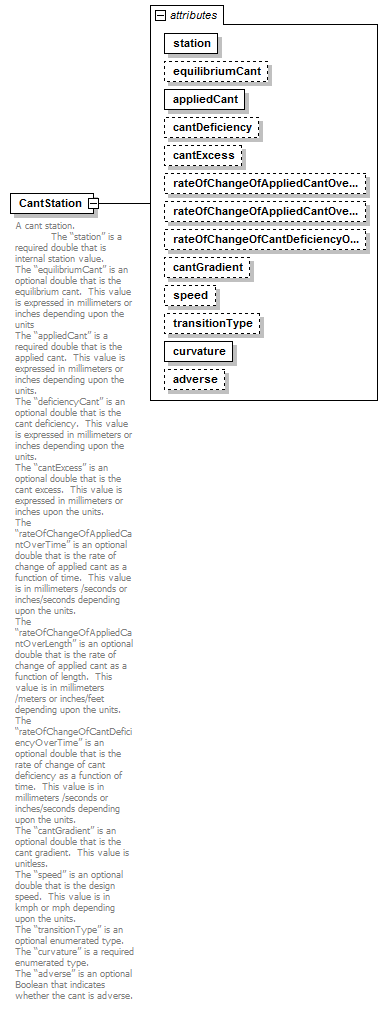| diagram |  |
||||||||||||||||||||||||||||||||||||||||||||||||||||||||||||||||||||||||||||||||||||
| namespace | http://www.landxml.org/schema/LandXML-1.2 | ||||||||||||||||||||||||||||||||||||||||||||||||||||||||||||||||||||||||||||||||||||
| properties |
|
||||||||||||||||||||||||||||||||||||||||||||||||||||||||||||||||||||||||||||||||||||
| used by |
|
||||||||||||||||||||||||||||||||||||||||||||||||||||||||||||||||||||||||||||||||||||
| attributes |
|
||||||||||||||||||||||||||||||||||||||||||||||||||||||||||||||||||||||||||||||||||||
| annotation |
|
||||||||||||||||||||||||||||||||||||||||||||||||||||||||||||||||||||||||||||||||||||
| source | <xs:element name="CantStation"> <xs:annotation> <xs:documentation>A cant station. The “station” is a required double that is internal station value. The “equilibriumCant” is an optional double that is the equilibrium cant. This value is expressed in millimeters or inches depending upon the units The “appliedCant” is a required double that is the applied cant. This value is expressed in millimeters or inches depending upon the units. The “deficiencyCant” is an optional double that is the cant deficiency. This value is expressed in millimeters or inches depending upon the units. The “cantExcess” is an optional double that is the cant excess. This value is expressed in millimeters or inches upon the units. The “rateOfChangeOfAppliedCantOverTime” is an optional double that is the rate of change of applied cant as a function of time. This value is in millimeters /seconds or inches/seconds depending upon the units. The “rateOfChangeOfAppliedCantOverLength” is an optional double that is the rate of change of applied cant as a function of length. This value is in millimeters /meters or inches/feet depending upon the units. The “rateOfChangeOfCantDeficiencyOverTime” is an optional double that is the rate of change of cant deficiency as a function of time. This value is in millimeters /seconds or inches/seconds depending upon the units. The “cantGradient” is an optional double that is the cant gradient. This value is unitless. The “speed” is an optional double that is the design speed. This value is in kmph or mph depending upon the units. The “transitionType” is an optional enumerated type. The “curvature” is a required enumerated type. The “adverse” is an optional Boolean that indicates whether the cant is adverse. </xs:documentation> </xs:annotation> <xs:complexType> <xs:attribute name="station" type="xs:double" use="required"/> <xs:attribute name="equilibriumCant" type="xs:double" use="optional"/> <xs:attribute name="appliedCant" type="xs:double" use="required"/> <xs:attribute name="cantDeficiency" type="xs:double" use="optional"/> <xs:attribute name="cantExcess" type="xs:double" use="optional"/> <xs:attribute name="rateOfChangeOfAppliedCantOverTime" type="xs:double" use="optional"/> <xs:attribute name="rateOfChangeOfAppliedCantOverLength" type="xs:double" use="optional"/> <xs:attribute name="rateOfChangeOfCantDeficiencyOverTime" type="xs:double" use="optional"/> <xs:attribute name="cantGradient" type="xs:double" use="optional"/> <xs:attribute name="speed" type="xs:double" use="optional"/> <xs:attribute name="transitionType" type="spiralType" use="optional"/> <xs:attribute name="curvature" type="clockwise" use="required"/> <xs:attribute name="adverse" type="xs:boolean" use="optional"/> </xs:complexType> </xs:element> |
attribute CantStation/@station
| type | xs:double | ||||
| properties |
|
||||
| source | <xs:attribute name="station" type="xs:double" use="required"/> |
attribute CantStation/@equilibriumCant
| type | xs:double | ||||
| properties |
|
||||
| source | <xs:attribute name="equilibriumCant" type="xs:double" use="optional"/> |
attribute CantStation/@appliedCant
| type | xs:double | ||||
| properties |
|
||||
| source | <xs:attribute name="appliedCant" type="xs:double" use="required"/> |
attribute CantStation/@cantDeficiency
| type | xs:double | ||||
| properties |
|
||||
| source | <xs:attribute name="cantDeficiency" type="xs:double" use="optional"/> |
attribute CantStation/@cantExcess
| type | xs:double | ||||
| properties |
|
||||
| source | <xs:attribute name="cantExcess" type="xs:double" use="optional"/> |
attribute CantStation/@rateOfChangeOfAppliedCantOverTime
| type | xs:double | ||||
| properties |
|
||||
| source | <xs:attribute name="rateOfChangeOfAppliedCantOverTime" type="xs:double" use="optional"/> |
attribute CantStation/@rateOfChangeOfAppliedCantOverLength
| type | xs:double | ||||
| properties |
|
||||
| source | <xs:attribute name="rateOfChangeOfAppliedCantOverLength" type="xs:double" use="optional"/> |
attribute CantStation/@rateOfChangeOfCantDeficiencyOverTime
| type | xs:double | ||||
| properties |
|
||||
| source | <xs:attribute name="rateOfChangeOfCantDeficiencyOverTime" type="xs:double" use="optional"/> |
attribute CantStation/@cantGradient
| type | xs:double | ||||
| properties |
|
||||
| source | <xs:attribute name="cantGradient" type="xs:double" use="optional"/> |
attribute CantStation/@speed
| type | xs:double | ||||
| properties |
|
||||
| source | <xs:attribute name="speed" type="xs:double" use="optional"/> |
attribute CantStation/@transitionType
| type | spiralType | ||||||||||||||||||||||||||||||||
| properties |
|
||||||||||||||||||||||||||||||||
| facets |
|
||||||||||||||||||||||||||||||||
| source | <xs:attribute name="transitionType" type="spiralType" use="optional"/> |
attribute CantStation/@curvature
| type | clockwise | ||||
| properties |
|
||||
| facets |
|
||||
| source | <xs:attribute name="curvature" type="clockwise" use="required"/> |
attribute CantStation/@adverse
| type | xs:boolean | ||||
| properties |
|
||||
| source | <xs:attribute name="adverse" type="xs:boolean" use="optional"/> |
XML Schema documentation generated by XMLSpy Schema Editor http://www.altova.com/xmlspy